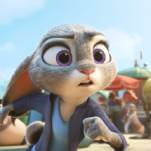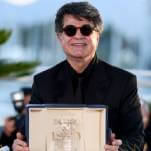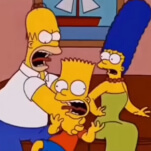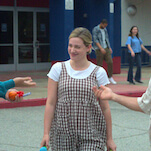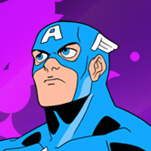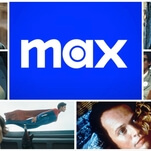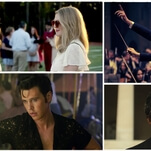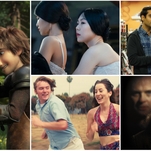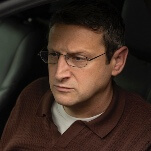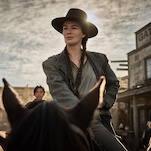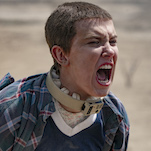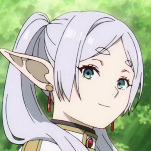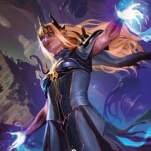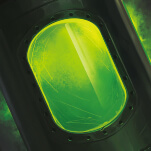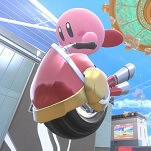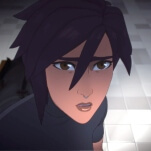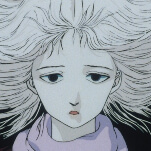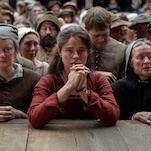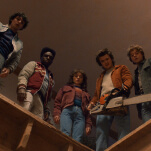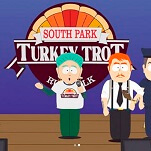The box art is instantly familiar. We see an anthropomorphic panda, all tubby and cute, leaping into the air for a high kick, with one hand curled into a fist and the other extended for a karate chop. In the background, we see ancient Chinese architecture and lanterns. There’s no doubt what this DVD is. It’s… Chop Kick Panda.
But what’s most notable about Chop Kick Panda—to me at least—is how choked this little movie-ette is with sentiment. In addition to the “find the hero within” message, the story adds a love interest for Lu’s son, and a backstory that has Lu as a single parent whose wife has died. That’s a lot of emotional arcs to work into a low-budget, 40-minute knock-off. But hey, if the low-end kids’ entertainment companies are going to copy big studio characters and premises, they may as well copy their “heart,” too. Because if you’re making a children’s movie these days, you gotta have heart—even if it means giving the story a thematic core to which kids can’t really relate.
Two summers ago, for example, I took my daughter to see Ice Age: Dawn Of The Dinosaurs. I wasn’t expecting much, since I hadn’t really liked the first Ice Age and hadn’t bothered to see the second. Still, about 10 minutes into Dawn Of The Dinosaurs, as Manny The Mammoth was worrying himself into a frazzle over the impending birth of his first child, and his friends Diego and Sid were moping about whether the old gang was going to break up (or perhaps just lose its killer edge), I found myself wondering, “Who is this movie for?”
I had the same thought a couple of times this past weekend while watching Kung Fu Panda 2. I thought the first Kung Fu Panda was one of the best action movies of 2008 (animated or otherwise), and for the most part I enjoyed Kung Fu Panda 2 as well. The big fight sequences are rousing and imaginative, with magnificent visual detail and a fine sense of scope, and the story—which sees Po challenged by a peacock who hopes to rule China with the aid of enormous cannons—is suitably weighty. But it’s because the central story is so strong that I became impatient with the additional baggage Kung Fu Panda 2 tries to lug around. It turns out that the peacock is also responsible for Po being taken from his panda parents and left to be raised by a goose. So throughout the movie, Po is plagued by previously suppressed memories of his traumatic youth, and he’s struggling with his feelings about the only father he’s ever really known, and he’s trying to harness what his master calls “inner peace.” Kung Fu Panda 2 has trouble getting a rhythm going because every time it seems like it’s settling into a rip-roaring superteam adventure, the story pauses so that Po and Tigress can have a touchy-feely conversation that suits neither character.
Look, I’m not opposed to emotional resonance in children’s movies—far from it. The Pixar movies have proven incredibly effective at integrating material designed more to reach the grown-ups in the crowd, playing on feelings of nostalgia, parental anxiety, professional embarrassment, disappointment, romantic love, and loss. But Pixar is also efficient with its storytelling; movies like Up and Toy Story 3 tend to establish their emotional stakes early, then get on with the action and comedy, bringing back their deeper themes in brief, well-earned grace notes throughout the film. And last year, two animated features I liked even more than Toy Story 3—How To Train Your Dragon and Tangled—deftly worked in ideas about the pressure of living up to parental expectations, which is something both kids and adults can connect with.
By contrast, last year’s Megamind—a movie that should’ve been far more entertaining than it turned out to be—stopped dead in its tracks about halfway through for a romantic subplot too mature for the youngsters and too simplistic for adults. Which wouldn’t have been a major problem if the love story between the titular villain and a plucky lady reporter felt organic. But it didn’t. It felt like something the creators of Chop Kick Panda might’ve come up with after deconstructing the story beats of the past decade’s most popular children’s movies. It felt engineered.
Granted, I can be a cranky old man when it comes to these matters. Back when my children were young enough to enjoy Saturday morning storytime at our local public library, I much preferred the story lady who read books quietly and talked about her favorite authors to the one who played music between stories and encouraged the kids to get up and dance. I distrust pandering, even when it’s in the right spirit. And too often with modern children’s movies, it seems like the creators insert tearjerker beats with the same cynical calculation that they insert farting monkeys. They’re turning sentiment into formula. What hath Pixar wrought?



